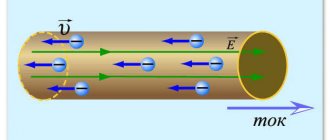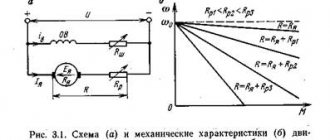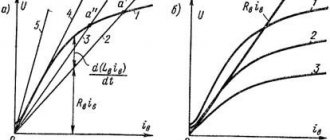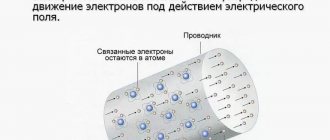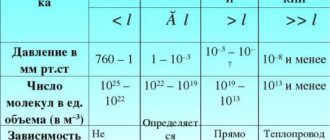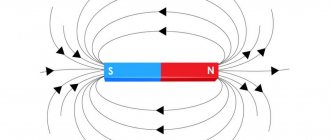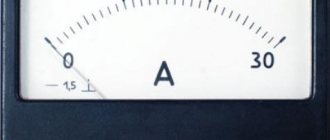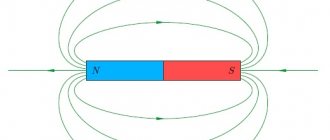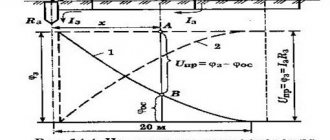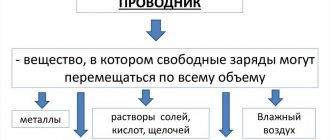Electricity. Conditions for the existence of current. Basic concepts.
Electric current is the directionally ordered movement of electric charges. The direction of current is taken to be the direction of movement of positive charges.
The passage of current through a conductor is accompanied by the following actions: * magnetic (observed in all conductors) * thermal (observed in all conductors except superconductors) * chemical (observed in electrolytes). For the occurrence and maintenance of current in any medium, two conditions must be met: * the presence of free electric charges in the medium * the creation of an electric field in the medium. An electric field in a medium is necessary to create directional movement of free charges. As is known, a charge q in an electric field of intensity E is acted upon by a force F = q* E, which causes free charges to move in the direction of the electric field. A sign of the existence of an electric field in a conductor is the presence of a non-zero potential difference between any two points of the conductor. However, electric forces cannot maintain an electric current for a long time. The directed movement of electric charges after some time leads to equalization of potentials at the ends of the conductor and, consequently, to the disappearance of the electric field in it. To maintain current in an electrical circuit, charges must be subject to forces of a non-electrical nature (external forces) in addition to Coulomb forces. A device that creates external forces, maintains a potential difference in a circuit and converts various types of energy into electrical energy is called a current source. For the existence of electric current in a closed circuit, it is necessary to include a current source in it. main characteristics 1. Current strength - I, unit of measurement - 1 A (Ampere). Current strength is a quantity equal to the charge flowing through the cross section of a conductor per unit time. I = Dq/Dt. The formula is valid for direct current, in which the current strength and its direction do not change over time. If the strength of the current and its direction change over time, then such a current is called alternating. For alternating current: I = lim Dq/Dt, Dt - 0 i.e. I = q', where q' is the time derivative of the charge. 2. Current density - j, unit of measurement - 1 A/m2. Current density is a value equal to the current flowing through a unit cross-section of a conductor: j = I/S. 3. Electromotive force of the current source - emf. ( e ), unit of measurement is 1 V (Volt). E.m.f. is a physical quantity equal to the work done by external forces when moving a single positive charge along an electrical circuit: e = Ast./q. 4. Conductor resistance - R, unit of measurement - 1 Ohm. Under the influence of an electric field in a vacuum, free charges would move accelerated. In matter they move uniformly on average, because part of the energy is given to particles of matter during collisions. The theory states that the energy of the ordered movement of charges is dissipated by distortions of the crystal lattice. Based on the nature of electrical resistance, it follows that R = r*l/S, where l is the length of the conductor, S is the cross-sectional area, r is a proportionality coefficient called the resistivity of the material. This formula is well confirmed by experience. The interaction of conductor particles with charges moving in a current depends on the chaotic movement of the particles, i.e. on the temperature of the conductor. It is known that r = r0(1 + at) , R = R0(1 + at) . Coefficient a is called the temperature coefficient of resistance: a = (R - R0)/R0*t. For chemically pure metals a > 0 and equals 1/273 K-1. For alloys, temperature coefficients are less important. The r(t) dependence for metals is linear: In 1911, the phenomenon of superconductivity was discovered, which consists in the fact that at a temperature close to absolute zero, the resistance of some metals drops abruptly to zero. For some substances (for example, electrolytes and semiconductors), the resistivity decreases with increasing temperature, which is explained by an increase in the concentration of free charges. The reciprocal of resistivity is called electrical conductivity ss = 1/r. 5. Voltage - U, unit of measurement - 1 V. Voltage is a physical quantity equal to the work done by external and electrical forces when moving a single positive charge. U = (Ast.+ Ael.)/q. Since Ast./q = e, and Ael./q = f1-f2, then U = e + (f1 - f2).
Electric current and conditions of its existence. Conditions for the existence of electric current
First, let’s answer the question of what electric current is. A simple battery standing on a table does not create current on its own. And a flashlight lying on the table will not create a current through its LEDs just like that, for no reason at all. For current to appear, something must flow somewhere, or at least begin to move, and for this to happen, the circuit of the flashlight’s LEDs and the battery must be closed. Not for nothing, in the old days electric current was compared to the movement of some charged liquid.
In fact, we now know that electric current is the directed movement of charged particles, and that a closer analogue to reality would be a charged gas - a gas of charged particles moving under the influence of an electric field. But first things first.
Electric current is the directed movement of charged particles
So, electric current is the movement of charged particles, but even the chaotic movement of charged particles is also movement, but it is not yet current. Likewise, the molecules of a liquid, which are always in thermal motion, do not create a flow, because the total movement of the entire volume of a liquid at rest is exactly zero.
For liquid flow to occur, total movement must occur, that is, the overall movement of liquid molecules must become directed. So the chaotic movement of molecules will combine with the directed movement of the entire volume, and a flow of the entire volume of liquid will arise.
The situation is similar with electric current - the directed movement of electrically charged particles is electric current. The speed of thermal movement of charged particles, for example in metal, is measured in hundreds of meters per second, but during directed movement, when a certain current is installed in the conductor, the speed of the overall movement of particles is measured in fractions and units of millimeters per second.
So, if a direct current of 10 A flows in a metal conductor with a cross-section of 1 sq. mm, then the average speed of the ordered movement of electrons will be from 0.6 to 6 millimeters per second. This will already be an electric current. And this slow movement of electrons is enough for a conductor, for example made of nichrome, to warm up quite well, obeying.
The speed of particles is not the speed of propagation of the electric field!
Note that the current begins in the conductor almost instantly throughout the entire volume, that is, this “movement” spreads through the conductor at the speed of light, but the movement of the charged particles themselves is 100 billion times slower. You can consider the analogy of a pipe through which liquid flows.
1. Charged particles are necessary for the existence of electric current
Electrons in metals and in vacuum, ions in electrolyte solutions serve as charge carriers and ensure the presence of current in various substances. In metals, electrons are very mobile, some of them can freely move from atom to atom, like a gas filling the space between the nodes of the crystal lattice.
In vacuum tubes, electrons leave the cathode in the process of thermionic emission, rushing under the influence of an electric field to the anode. In electrolytes, molecules break up in water into positively and negatively charged parts, and become ions - free charge carriers in electrolytes. That is, wherever an electric current can exist, there are free charge carriers capable of moving. This is the first condition for the existence of electric current - the presence of free charge carriers.
2. The second condition for the existence of electric current is that external forces must act on the charge
If you now look at a conductor, let’s say it’s a copper wire, you can ask the question: what is needed for an electric current to arise in it? There are charged particles, electrons, and they are able to move freely.
What will make them move? It is known that an electrically charged particle interacts with an electric field. Therefore, it is necessary to create an electric field in the conductor, then a potential will arise at each point of the conductor, there will be a potential difference between the ends of the conductor, and the electrons will move in the direction of the field - in the direction from “-” to “+”, that is, in the opposite direction electric field strength vector. The electric field will accelerate the electrons, increasing their (kinetic and magnetic) energy.
As a result, if we simply consider an electric field applied externally to a conductor (we placed the conductor in an electric field along the lines of force), then electrons will begin to accumulate at one end of the wire, and a negative charge will arise at this end, and since electrons have shifted from the other end of the wire, then it will have a positive charge.
As a result, the electric field of a conductor charged by an externally applied electric field will be in such a direction as to weaken the external electric field by its action.
The process of charge redistribution will occur almost instantly, and upon completion, the current in the conductor will stop. The resulting electric field inside the conductor will become zero, and the intensity at the edges will be equal in magnitude, but opposite in direction to the electric field applied outside.
If the electric field in a conductor is created by a direct current source, for example a battery, then such a source will become a source of external forces for the conductor, that is, a source that will create a constant EMF in the conductor and will maintain a potential difference. Obviously, in order for the current to be maintained by a source of external forces, the circuit must be closed.
And again, good day to you, dear ones. Without further preludes, let's begin our conversation today. It would seem that we have long ago figured out the reasons for the occurrence of current in a conductor. We placed a conductor in the field - electrons began to flow and a current arose. What else does. But it turns out that in order for this current to exist in the conductor constantly, certain conditions must be met. For a clearer understanding of the physics of the process of electric current flow in a conductor, let's consider an example.
Let's assume that we have some conductor, which we will place in an electric field as shown in Figure 4.1.
Figure 4.1 – Conductor in an electric field
Conventionally, we denote the voltage value at the ends of the conductor as E 1 and E 2, with E 1 >E 2. As we found out earlier, free electrons in the conductor will begin to move towards a higher field strength, that is, to point A. However, over time, the potential formed by the accumulation of electrons at point A will become such that the own electromagnetic field E 0 created by it will be equal in magnitude to the external one field, and the directions of the fields will be opposite, since the potential of point B is more positive (lack of electrons caused by the influence of an external field).
Since the resulting action of two identical opposite forces is zero: |E|+|(E 0)|=0, the electrons stop their ordered motion and the electric current stops. In order for the flow of electrons to be continuous, it is necessary: firstly, to apply an additional force of a non-potential nature, which would compensate for the influence of the conductor’s own electric field and, secondly, to create a closed loop, since the movement of electrons can only occur in conductors (previously we indicated that dielectrics, although they have some electrical conductivity, do not transmit electric current) and to ensure the constancy of the compensating force, the constancy of the fields is necessary: both external and intrinsic.
Let's start with the second point. We will consider a conductor placed in a field, as shown in Figure 4.2. Let us assume that after the interaction of the external and internal electromagnetic fields has been compensated, we additionally apply another similar field to the external field. The total effect of the external field will be 2 |E|. The current in the conductor will continue to flow in the same direction, but exactly until the moment 2 |E|>|E 0 |, after which the electric current will stop again. That is, the external influence must increase continuously to ensure the flow of current in an open conductor, which is impossible. If you close the conductor so that one part of it lies outside the field, then due to the work of an additional force in addition to the external field (this force in this case should not be potential, since the work of a potential force in a closed loop is zero and does not depend on the shape of the trajectory), then an electric current will arise in the conductor due to the influence of only the external field, since the conductor field itself will be completely compensated. That is why any electrical circuit must always be closed.
You can try to explain the need to introduce additional force from the following consideration: if we could partially transfer charges from end B of the conductor to end A of the conductor, the electric current would also not stop. However, such a “landing” also requires energy. This means that the introduction of additional force is still necessary. Non-potential forces are also called third-party forces. And their sources are sources or generators of current.
Figure 4.2 – Emergence of its own electromagnetic field in a conductor
So where can we get additional force, which, moreover, should not be created by the field, because without it we will not get current? It turns out that during a chemical redox reaction, for example, the interaction of lead dioxide and dilute sulfuric acid, free electrons are released:
In order to “attract” all the electrons released during the reaction to one point in space, several lead grids called electrodes are placed in a solution of sulfuric acid. One part of the electrodes is made of lead and is called the cathode, the other - the anode - is made of lead dioxide. The cathode is a source of free electrodes for the external circuit, and the anode is a receiver.
The given example corresponds to a device known to all motorists (and not only) - a lead-acid battery. Of course, the example given has little overlap with what happens inside the battery in reality, however, the essence of the occurrence of current reflects well. Thus, an electric field arises between the positive anode (few electrons) and the negative cathode (many electrons), which generates external forces and creates a current in the conductor. This force depends only on the course of the chemical reaction; it is practically constant until the elements of this reaction - acid and lead oxide - exist. Therefore, if we remove the electric field and connect a conductor to the anode and cathode, electric current will still flow due to the battery creating an external force. The conductor will have its own electric field around it, which the battery must overcome in order to transfer an electron from the cathode to the anode. This is the essence of outside force.
Now consider the situation with a battery and a conductor connected to it. The electric field does positive work to move a positive charge (we are talking about positive charges, since the direction of their movement corresponds to the direction of the current) in the direction of decreasing the field potential. The current source separates electrical charges - positive charges accumulate on one pole and negative charges on the other. The electric field strength in the source is directed from the positive pole to the negative pole, so the work of the electric field to move a positive charge will be positive when it moves from “plus” to “minus”. The work of external forces, on the contrary, is positive if positive charges move from the negative pole to the positive, that is, from “minus” to “plus.” This is the fundamental difference between the concepts of potential difference and EMF, which must always be remembered.
Figure 4.3 shows the direction of current flow I in the conductor connected to the battery - from the positive anode to the negative cathode, however, inside the battery, external chemical reaction forces produce “dropping” of electrons that came from the external circuit from the anode to the cathode and positive ions from the cathode to the anode, that is, they act against the direction of current movement and the direction of the field.
Figure 4.3 – Demonstration of third-party forces when an electric current occurs
From the above considerations, we can draw the following conclusion: the forces acting on the charge inside the current source are different from the forces acting inside the conductor. Accordingly, it is necessary to distinguish these forces from each other. To characterize external forces, the value of electromotive force (EMF) was introduced - the work done by external forces to move a single positive charge. It is denoted by the Latin letter ε (“epsilon”) and is measured in the same way as the potential difference - in volts.
Since the potential difference and EMF are forces of different types, we can say that the EMF outside the source terminals is zero. Although in ordinary life these subtleties are neglected and they say: “The voltage on the battery is 1.5V,” although strictly speaking, the voltage on a section of the circuit is the total work of electrostatic and third-party forces to move a single positive charge. In the future, we will still encounter these concepts and they will be useful to us when calculating complex electrical circuits.
That's probably all, because the lesson turned out to be too loaded... But you need to be able to distinguish the concepts of voltage and EMF.
- For the existence of electric current, two conditions are necessary: 1) a closed electrical circuit; 2) the presence of a source of third-party non-potential forces.
- Electromotive force (EMF) is the work done by external forces to move a single positive charge.
- Sources of external forces in an electrical circuit are also called current sources.
- The positive terminal of the battery is called the anode, the negative terminal is called the cathode.
There will be no problems this time; it’s better to repeat this lesson again in order to understand the entire physics of current flow in a conductor. As always, you can leave any questions, suggestions and wishes in the comments below! See you again!
For the emergence and existence of a constant electric current in a substance, it is necessary, firstly, the presence of free charged particles. If positive and negative charges are bonded to each other in atoms or molecules, their movement will not produce an electric current.
But the presence of free charges is not yet sufficient for the generation of current. To create and maintain the ordered movement of charged particles, it is necessary, secondly, to act on them in a certain direction. If this force ceases to act, then the ordered movement of charged particles will cease due to the resistance provided to their movement by ions of the crystal lattice of metals or neutral molecules of electrolytes.
Charged particles, as we know, are affected by an electric field with a force. Usually, it is the electric field inside the conductor that serves as the cause that causes and maintains the ordered movement of charged particles. Only in the static case, when the charges are at rest, the electric field inside the conductor is zero.
If there is an electric field inside the conductor, then between the ends of the conductor, in accordance with formula (8.28), there is a potential difference. When this potential difference does not change over time, a constant current is established in the conductor. Along the conductor, the potential decreases from a maximum value at one end of the conductor to a minimum value at the other. This decrease in potential can be detected by simple experiment.
As a guide, take a not very dry wooden stick and hang it horizontally. (Such a stick, although poorly, still conducts current.) Let the voltage source be an electrostatic machine. To record the potential of different sections of the conductor relative to the ground, you can
use pieces of metal foil attached to a stick. We connect one pole of the machine to the ground, and the second to one end of the conductor (stick). The chain will not be closed. When we rotate the handle of the machine, we will find that all the leaves are deflected at the same angle (Fig. 146). This means that the potential of all points of the conductor relative to the ground is the same. This is how it should be if the charges on the conductor are in balance. If the other end of the stick is now grounded, then when the machine handle is rotated, the picture will change. (Since the earth is a conductor, grounding the conductor makes the circuit closed.) At the grounded end, the leaves will not diverge at all: the potential of this end of the conductor is almost equal to the potential of the ground (the potential drop in a metal wire is small). The maximum angle of divergence of the leaves will be at the end of the conductor connected to the machine (Fig. 147). A decrease in the angle of divergence of the leaves as they move away from the machine indicates a drop in potential along the conductor.
1. What is called electric current? 2. What is called current strength?
3. Which direction of the current is considered positive? 4. What conditions are necessary for the existence of electric current?
If an electric field is applied to an insulated conductor, then a force =q will act on the free charges q in the conductor. As a result, an ordered movement of free charges occurs in the conductor, and an electric current arises.
The continuous ordered movement of free electric charge carriers is called electric current.
The direction of the electric current is taken to be the direction of movement of positive free charges.
Conditions necessary for the existence of electric current:
—
the presence of free charged particles;
Presence of an electric field;
– closed circuit.
The action of current accompanying its flow:
1) Thermal.
The conductor through which current flows heats up. Thermal effects are almost always present. An exception is the phenomenon of superconductivity; the thermal effect of current does not appear when current flows in a vacuum.
2) Chemical
. Electric current changes the chemical composition of the conductor. Observed when current flows in electrolytes.
3) Magnetic.
The current exerts a force on neighboring currents and on magnetic bodies. Magnetic influence on neighboring points and on magnetic bodies. The magnetic effect, in contrast to the chemical and thermal phenomena, is the main one, since it manifests itself in all conductors without exception (it is always observed).
Electric current in conductors (metals) is always due to the presence of free electrons.
Positively charged metal ions form a crystal lattice. A “free electron gas” is formed by one or more electrons given up by each atom. Free electrons are able to wander throughout the entire volume of the crystal.
Current strength
is a scalar physical quantity numerically equal to the electric charge passing through the cross section of a conductor per unit time:
If the magnitude of the current and its direction do not change over time, then the current is called constant and I=const=.
The unit of current is 1 Ampere. The ampere in the SI system is the basic unit and is determined from the magnetic interaction of two parallel straight conductors carrying a current of 1 A in one direction, located at a distance of 1 m from each other in a vacuum, causing an interaction force between these conductors equal to 2 * 10 -7 N per meter of length.
The current strength depends on the charge of the particle e, the concentration n, the speed of the particles v and the cross-sectional area of the conductor S:
I= = = , where q=eN; n-particle concentration; V=vtS contains N=nV particles.
Current density
is a vector quantity numerically equal to the current per unit area oriented perpendicular to the current: .
Vector j is directed along the current along the vector of the electric field strength in the conductor. In the SI system, current density is measured in A/m 2. For DC
Ticket 25.1
First law of thermodynamics
- one of the three basic laws of thermodynamics, is the law of conservation of energy for thermodynamic systems.
The first law of thermodynamics was formulated in the middle of the 19th century as a result of the work of the German scientist J. R. Mayer, the English physicist J. P. Joule and the German physicist G. Helmholtz. According to the first law of thermodynamics, a thermodynamic system can perform work only due to its internal energy or any external energy sources. The first law of thermodynamics is often formulated as the impossibility of the existence of a perpetual motion machine of the first kind, which would do work without drawing energy from any source.
In thermodynamics, the concepts of molar heat capacity at constant volume CV and molar heat capacity at constant pressure C p are widely used. In an ideal gas they satisfy the Mayer equation:
The work ΔA performed by the gas is determined by the gas pressure and the change in its volume:
In an isochoric process, the gas does no work, and ΔU = Q. In an isobaric process, A = pΔV = p (V 2 – V 1). In an isothermal process, ΔU = 0, and A = Q; all the heat transferred to the body goes to work on external bodies. Graphically, work is equal to the area under the process curve on the p, V plane.
Adiabatic is a quasi-static process in which no heat is transferred to the system from the environment: Q = 0. In an adiabatic process, all the work is done due to the internal energy of the gas.
Heat capacity
body (usually denoted by the Latin letter
C
) is a physical quantity that determines the ratio of the infinitesimal amount of heat δ
Q
received by the body to the corresponding increment in its temperature δ
T
:
The SI unit of heat capacity is J/K.
Specific heat
Specific heat capacity
is called the heat capacity per unit amount of a substance. The amount of a substance can be measured in kilograms, cubic meters and moles. Depending on which quantitative unit the heat capacity belongs to, mass, volumetric and molar heat capacity are distinguished.
Mass heat capacity ( C
) is the amount of heat that must be supplied to a unit mass of a substance in order to heat it by a unit temperature. In SI it is measured in joules per kilogram per kelvin (J kg −1 K −1).
Volumetric heat capacity ( C′
) is the amount of heat that must be supplied to a unit volume of a substance in order to heat it per unit temperature. In SI it is measured in joules per cubic meter per kelvin (J m −3 K −1).
Molar heat capacity ( C
μ) is the amount of heat that must be supplied to 1 mole of a substance to heat it per unit temperature. In SI it is measured in joules per mole per kelvin (J/(mol K)).
Electricity
- directionally ordered movement of electric charges.
The direction of current is taken to be the direction of movement of positive
charges.
The passage of current through a conductor is accompanied by the following actions:
CONDITIONS
FOR THE EXISTENCE OF ELECTRIC CURRENT
For the occurrence and maintenance of current in any environment, two conditions must be met:
In different environments, the carriers of electric current are different charged particles.
To maintain current in an electrical circuit
In addition to Coulomb forces, charges must be acted upon by forces
of a non-electrical
nature (external forces).
A device that creates external forces, maintains a potential difference in a circuit and converts various types of energy into electrical energy is called a current source.
For the existence of electric current in a closed circuit, it is necessary to include a current source in it
Main characteristics
1.
Current strength - I, unit of measurement - 1 A (Ampere).
Current strength is a quantity equal to the charge flowing through the cross section of a conductor per unit time.
I = q/t.(1)
Formula (1) is valid for direct current,
in which the current strength and its direction do not change over time.
If the strength of the current and its direction change over time, then such a current is called alternating.
For AC:
I = lim q/t , (*) t — 0
those. I = q", where q" is the time derivative of the charge.
2.
Current density - j, unit of measurement - 1 A/m 2.
Current density is a value equal to the strength of the current flowing through a unit cross-section of a conductor:
j = I/S.(2)
3.
Electromotive force of the current source - emf. (), unit of measurement is 1 V (Volt). Emf is a physical quantity equal to the work done by external forces when moving a single positive charge along an electrical circuit:
= A st. /q.(3)
4.
Conductor resistance is R, unit of measurement is 1 Ohm.
Under the influence of an electric field in a vacuum, free charges would move accelerated. In matter they move uniformly on average, because part of the energy is given to particles of matter during collisions.
The theory states that the energy of the ordered movement of charges is dissipated by distortions of the crystal lattice. Based on the nature of electrical resistance, it follows that
R = *l/S , (4)
l
is the length of the conductor, S is the cross-sectional area, is a proportionality coefficient called the resistivity of the material.
5.
Voltage - U, unit of measurement - 1 V. Voltage is a physical quantity equal to the work done by external and electrical forces when moving a single positive charge.
U = (A st. + A el.)/q .(8)
Since A st. /q = , and A el. /q = , then
U = + (
